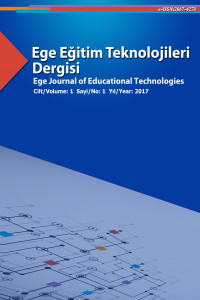Öz
Design thinking is a rising term in educational
literature and role of design thinking in classrooms is one of current research
subjects in these days. Design thinking a general approach that utilize the
designer’s methods and sensibility to overcome problems in efficient and
effective way in terms of technological and commercial aspects. In educational
context, it is seen as a learning approach that mainly focuses on developing
creative confidence of students. Before the emergence of design thinking, in educational
literature design as a keyword has been one of the most used term in
educational researches, as well. Design based learning, learning by design,
reflective design based learning, learning technology by design are several
examples. Therefore, it is necessary to recognize that whether design thinking
is entirely new phenomena for educators or it is just the replication of
previous design related learning approaches. In this paper, definition and
current position of design thinking in the literature and relationship between
design thinking and previous design related learning approaches has
discussed. It is obtained that design
thinking is sparkling phenomena yet it doesn’t completely new approach for
educators and it has several similarities in both practice and theoretical
perspective with earlier design-related educational studies.
Anahtar Kelimeler
Kaynakça
- Agogino, A. M., Beckman, S. L., Castaños, C., Kramer, J., Roschuni, C., & Yang, M. (2015). Design Practitioners â€TM Perspectives on Methods for Ideation and Prototyping Design Practitioners ’ Perspectives on Methods for Ideation and Prototyping. In Mudd Design Workshop IX (pp. 117–131).
- Bekker, T., Bakker, S., Douma, I., van der Poel, J., & Scheltenaar, K. (2015). Teaching children digital literacy through design-based learning with digital toolkits in schools. International Journal of Child-Computer Interaction, 5, 29–38. https://doi.org/10.1016/j.ijcci.2015.12.001
- Brown, T. (2008). DELIVER ON A GREAT. Harvard Business Review, 85–92.
- Buchanan, R. (2001). Design Research and the New Learning. Design Issues, 17(4), 3–23. https://doi.org/10.1162/07479360152681056
- Buchanan, R. (1992). (1992). Wicked problems in design thinking. Design Issues, 8(2), 5-21., 8(2), 5–21.
- Carroll, M., Goldman, S., Britos, L., Koh, J., Royalty, A., & Hornstein, M. (2010). Destination, imagination and the fires within: Design thinking in a middle school classroom. International Journal of Art and Design Education, 29(1), 37–53. https://doi.org/10.1111/j.1476-8070.2010.01632.x
- Dorst, K. (2011). The core of “design thinking” and its application. Design Studies, 32(6), 521–532. https://doi.org/10.1016/j.destud.2011.07.006
- Gómez Puente, S. M., Jongeneelen, C., & Perrenet, J. (2012). Design-Based Learning in Mechanical Engineering Education. Project Approaches to Learning in Engineering Education: The Practice of Teamwork, 89–108.
- Gómez Puente, S. M., van Eijck, M., & Jochems, W. (2014). Professional development for design-based learning in engineering education: a case study. European Journal of Engineering Education, 40(1), 14–31. https://doi.org/10.1080/03043797.2014.903228
- Gómez Puente, S. M., Van Eijck, M., & Jochems, W. (2013). A sampled literature review of design-based learning approaches: A search for key characteristics. International Journal of Technology and Design Education, 23(3), 717–732. https://doi.org/10.1007/s10798-012-9212-x
- Kimbell, L. (2011). Rethinking Design Thinking: Part I. Design and Culture, 3(3), 285–306. https://doi.org/10.2752/175470811X13071166525216
- Koehler, M. J., Mishra, P., & Yahya, K. (2007). Tracing the development of teacher knowledge in a design seminar: Integrating content, pedagogy and technology. Computers and Education, 49(3), 740–762. https://doi.org/10.1016/j.compedu.2005.11.012
- Kurokawa, T. (2013). Design Thinking Education at Universities and Graduate Schools. Science & Technology Trends, 46, 50–63.
Ayrıntılar
| Konular | Eğitim Üzerine Çalışmalar |
|---|---|
| Bölüm | Derlemeler |
| Yazarlar | |
| Yayımlanma Tarihi | 30 Haziran 2017 |
| Gönderilme Tarihi | 24 Mart 2017 |
| Yayımlandığı Sayı | Yıl 2017 Cilt: 1 Sayı: 1 |
Index Copernicus, Asos Index, WorldCat, OpenAIRE, ROAD, BASE, Google Scholar, Academia.edu, Türk Eğitim İndeksi, IAD, EuroPub, Academindex
tarafından taranmaktadır.
Publisher
İzmir Akademi Derneği
www.izmirakademi.org
Dergi Ana Sayfası | Amaç & Kapsam | Yazar Rehberi | Politikalar | İndeksler | Kurullar | İletişim



